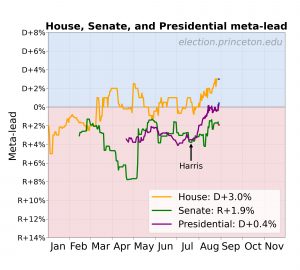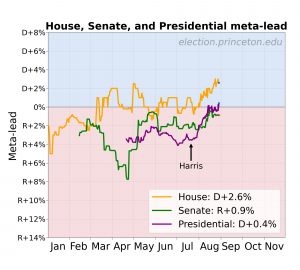Nebraska > Montana

We’re heading into a long weekend, but my report on the Senate poll snapshot is long overdue. We made two important updates this week.
First, we fixed an error – I’ll write more on that at the end of today’s piece. Second and more important, we added an important race, Nebraska. Nebraska has slipped under the national press’s radar. As it turns out, the race there is currently among the closest in the nation, closer than Texas and Florida. But in Nebraska, but an individual person’s vote, time, and donations are at least 10 times as powerful than in those big states. It’s a perfect demonstration of the Democracy Moneyball principle.
For close observers of politics, the conventional wisdom has been that Democrats face an uphill battle in retaining control of the United States Senate. In 2024, 42 Democratic/Independent seats are either not up for election or are safe Democratic/Independent and 47 seats were expected to go Republican. If true, that would leave control to be decided by the remaining 11 races. Democrats would need to win at least 8 of them to retain control (9 if Trump wins the Presidential election).
Currently, Democrats lead in 7 of those 11 races. That was true both before and after Democrat Kamala Harris entered the race. However, it is notable that with the entrance of Harris into the race, the races shifted overall toward Democrats. This is easy to see if we look at the meta-margin, which is the number of percentage points by which all races need to swing across-the-board to create a 50-50 Senate.
Here it is, superimposed with the meta-margin for the Presidency and for control of the U.S. House.

This graph shows that after Harris entered the race, all three indicators moved toward Democrats:
- The presidential has moved 4 points toward Harris, to D+0.4%;
- The House moved 3 points toward Democrats, to D+2.6%; and
- The Senate moved 2 points toward Democrats, to R+1.9%.
The aggregation approach of the Princeton Election Consortium (probabilistic snapshot of all states in a category, no fancy corrections) makes it easy to see that all three movements started around the same time. Evidently Harris has some coattails, as measured through surveys.
But then, enter Nebraska.
The Nebraska race escaped my attention until several close polls came up. There are not many surveys, but Republican incumbent Senator Deb Fischer only leads her challenger, independent Dan Osborn, by a median of 2 percentage points. That is rather amazing, considering that in 2018, she won re-election by 19 points. What’s going on?
First, Senator Fischer is pretty low-profile. She has not made much news during her time in the Senate. She did not cast aspersions on the honest conduct of the 2020 Presidential election, which distinguished her from her election-denier colleagues. That might make her a bit bland by current Republican standards.
Dan Osborn is an interesting candidate. He’s a steamfitter by trade, and became well known in 2021 for leading a successful strike at a Kellogg’s plant in Omaha. This year he competed for the Democratic Senate nomination – but then turned it down. Walking away from the Democratic Party is probably good for one’s reputation in Nebraska. And he’s gotten the support of the Legal Marijuana Now Party (LMN), which has ballot access in Nebraska but withdrew its candidate to make way for Osborn.
Osborn trails narrowly by a median of 2 points (see FiveThirtyEight, which provides our data feed). But in one survey, when respondents were read his biography and Senator Fischer’s, he jumped to a 53%-39% lead. So he has considerable upside potential. I don’t know if he can go the distance; that might be tough for an independent. Recall that in the 2014 Kansas Senate race, Greg Orman ran as an independent and kept things close, as I wrote at NewYorker.com at the time, but he faltered at the end. But for now, Osborn might be a game-changer.
When Nebraska is added to the PEC Senate snapshot, the entire time series now looks like this:

The whole Senate graph (in green) has moved upward. The reason is that the Nebraska seat moves from being treated as safe Republican to being competitive, based on data. Today it is the closest, followed by Florida with a narrow 3-point lead for the Republican. The overall meta-margin is R+0.9% because it factors in the possibility that in either state, the Democratic/Independent candidate might win. If one works through the probabilities, the resulting meta-margin for this 50th seat is therefore smaller. And anything between R+2.0% and D+2.0% should be considered a toss-up.
So, what does this mean for you? That is answered by the per-vote power index that we calculate. As of today, per-vote power is highest in Nebraska, with a per-vote power of 100 (2-point margin, 0.93 million votes cast in 2020) and Montana, with a per-vote power of 94 (6-point margin, 0.60 million votes cast). Both are far ahead of Florida’s per-vote power of 8 (3-point margin, 11.07 million votes cast).
Now consider that in 2018, the major candidates in Nebraska’s Senate race spent less than $9 million. Compare that with the $118 million spent in Florida. With Montana’s Senate campaign rumored to be funded to the tune of hundreds of millions of dollars, it is clear that Nebraska is the very best place to put Senate contributions. (You can give using this ActBlue or this WinRed; both are shown at the bottom of this website).
I will save for comments the major correction to the Senate tracker this week. Suffice it to say that the tracker is now fully accurate.





So, here is what happened to the Senate tracker. It is a little embarrassing.
When a student and I re-started the calculations for 2024, somebody modified this script. This change in indexing (boo indexing!) shifted the overall outcome by 1 Senate seat. You can see the error in line 36 of the script. For example, the probability calculated for 49 Democratic/Independent seats was assigned to an outcome of 50 seats. That shifted the entire histogram.
I apologize that this error took so long to correct. It’s accurate now. The new PEC software developer, Phousawanh, repaired it. Thank you, Phousawanh!
Thanks for the work you do here. I’ve been watching this space for several years and took specific interest in redistricting in Virginia.
In your comment you may have shared a link to the wrong script. I believe the correct link is [Senate_mediam.m](https://github.com/Princeton-Election-Consortium/data-backend/blob/master/matlab/Senate_median.m).
Proof positive that someone is looking at the scripts. Thank you!
Great analysis! Very grateful for these insights into the Nebraska Senate race.
Dan Osborn is ostensibly Independent. Are we fairly certain he will caucus with the Democrats?
The Senate graph shows that 50 D+I seats gives Democrats control of the Sentate, but this is true if and only if Harris-Walz win. If Trump-Vance win, then 50 D+I seats gives Republicans control of the Senate.
If you want to see that, you can go to the .
is there a numerical way of dealing with the simpson paradox in the ev? it appears that some of the absolute neg polls for harris are actually improvements from the respective pollster? i wonder if there is an EASY way of capturing this?
When I see the Kansas 2023 referendum which tried to overturn a legal decision in that state affirming a right to abortion was defeated 59% to 41%, I wonder why Kansas isn’t also a close state in this election. even though there’s no contested Senate seat there this cycle.
Approval for legal abortion is currently at 63% in favor, 36% opposed. This is the highest level of approval in the history of Gallup asking the question. Consequently pro-legal-abortion people can be Democrats, independents, or Republicans. Generally speaking, reproductive-rights initiatives get 10-15 points more support than Democratic Party vote share.
Consequences: (a) many issues correlate with party, but even abortion, one of the strongest correlates, still doesn’t sort perfectly; (b) ballot initiatives are particularly effective as a means of getting around legislatures that for partisan reasons do not follow the wishes of the people.